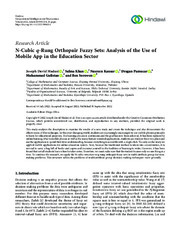Please use this identifier to cite or link to this item:
https://rfos.fon.bg.ac.rs/handle/123456789/2346Full metadata record
| DC Field | Value | Language |
|---|---|---|
| dc.creator | Madasi, Joseph David | |
| dc.creator | Khan, Salma | |
| dc.creator | Kausar, Nasreen | |
| dc.creator | Pamučar, Dragan | |
| dc.creator | Gulistan, Muhammad | |
| dc.creator | Sorowen, Ben | |
| dc.date.accessioned | 2023-05-12T11:42:48Z | - |
| dc.date.available | 2023-05-12T11:42:48Z | - |
| dc.date.issued | 2022 | |
| dc.identifier.issn | 1687-5265 | |
| dc.identifier.uri | https://rfos.fon.bg.ac.rs/handle/123456789/2346 | - |
| dc.description.abstract | This study analyzes the description to examine the results of a new study and create the technique and also demonstrate the effectiveness of this technique. In this ever-changing world, students are increasingly encouraged to use mobile phones primarily to learn for educational purposes. The learning process is continuous and the goal has now been achieved. It has been replaced by online learning. Due to mobile phones as well as the many feature-oriented applications, students can study at their own place and use the application to spend their time understanding, because everything is accessible with a single click. To carry on the study we applied mobile applications for online education system. Now, because the traditional method is taken into consideration, it is normal to carry a bag full of books and copies and immerse yourself in the tradition of learning to write. However, it has been found that not all students learn when he takes notes. Therefore, we must make sure that the student focuses only on one thing at a time. To continue the research, we apply the N-cubic structure to q-rung orthopair fuzzy sets in multi-attribute group decision-making problems. This structure solves the problems of multi-attribute group decision-making techniques more generally. | en |
| dc.publisher | Hindawi Ltd, London | |
| dc.rights | openAccess | |
| dc.rights.uri | https://creativecommons.org/licenses/by/4.0/ | |
| dc.source | Computational Intelligence and Neuroscience | |
| dc.title | N-Cubic q-Rung Orthopair Fuzzy Sets: Analysis of the Use of Mobile App in the Education Sector | en |
| dc.type | article | |
| dc.rights.license | BY | |
| dc.citation.other | 2022: - | |
| dc.citation.rank | M21~ | |
| dc.citation.volume | 2022 | |
| dc.identifier.doi | 10.1155/2022/9984314 | |
| dc.identifier.fulltext | http://prototype2.rcub.bg.ac.rs/bitstream/id/858/2342.pdf | |
| dc.identifier.pmid | 36210971 | |
| dc.identifier.rcub | conv_2779 | |
| dc.identifier.scopus | 2-s2.0-85139414361 | |
| dc.identifier.wos | 000869058600007 | |
| dc.type.version | publishedVersion | |
| item.cerifentitytype | Publications | - |
| item.fulltext | With Fulltext | - |
| item.grantfulltext | open | - |
| item.openairetype | article | - |
| item.openairecristype | http://purl.org/coar/resource_type/c_18cf | - |
| Appears in Collections: | Radovi istraživača / Researchers’ publications | |
This item is licensed under a Creative Commons License


